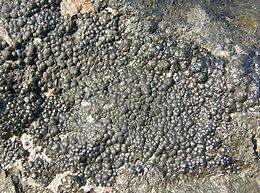| Uraninite | |
|---|---|
 Pitchblende from Niederschlema-Alberoda deposit, Germany | |
| General | |
| Category | Oxide minerals |
| Formula (repeating unit) | Uranium dioxide or uranium(IV) oxide (UO2) |
| IMA symbol | Urn[1] |
| Strunz classification | 4.DL.05 |
| Crystal system | Isometric |
| Crystal class | Hexoctahedral (m3m) H-M symbol: (4/m 3 2/m) |
| Space group | Fm3m |
| Unit cell | a = 5.4682 Å; Z = 4 |
| Identification | |
| Color | Steel-black to velvet-black, brownish black, pale gray to pale green; in transmitted light, pale green, pale yellow to deep brown and green-gray (thin fragments) |
| Crystal habit | Massive, botryoidal, granular. Octahedral crystals uncommon. |
| Cleavage | Indistinct |
| Fracture | Conchoidal to uneven |
| Mohs scale hardness | 5–6 |
| Luster | Submetallic, greasy, dull |
| Streak | Brownish black, gray, olive-green |
| Diaphaneity | Opaque; transparent in thin fragments |
| Specific gravity | 10.63–10.95; decreases on oxidation |
| Optical properties | Isotropic |
| Other characteristics | |
| References | [2][3][4][5] |
| Major varieties | |
| Pitchblende | Massive |
Uraninite, also known as pitchblende, is a radioactive, uranium-rich mineral and ore with a chemical composition that is largely UO2 but because of oxidation typically contains variable proportions of U3O8. Radioactive decay of the uranium causes the mineral to contain oxides of lead and trace amounts of helium. It may also contain thorium and rare-earth elements.[2][4]
- ^ Warr, L.N. (2021). "IMA–CNMNC approved mineral symbols". Mineralogical Magazine. 85 (3): 291–320. Bibcode:2021MinM...85..291W. doi:10.1180/mgm.2021.43. S2CID 235729616.
- ^ a b Klein, Cornelis and Cornelius S. Hurlbut, Jr., Manual of Mineralogy, Wiley, 1985, 20th ed. pp. 307–308 ISBN 0-471-80580-7
- ^ Anthony, John W.; Bideaux, Richard A.; Bladh, Kenneth W.; Nichols, Monte C. (eds.). "Uraninite". Handbook of Mineralogy (PDF). Vol. III (Halides, Hydroxides, Oxides). Chantilly, VA: Mineralogical Society of America. ISBN 0-9622097-2-4. Archived (PDF) from the original on March 14, 2012. Retrieved December 5, 2011.
- ^ a b Uraninite Archived November 10, 2012, at the Wayback Machine. Mindat.org
- ^ Uraninite Archived October 21, 2011, at the Wayback Machine. Webmineral.com